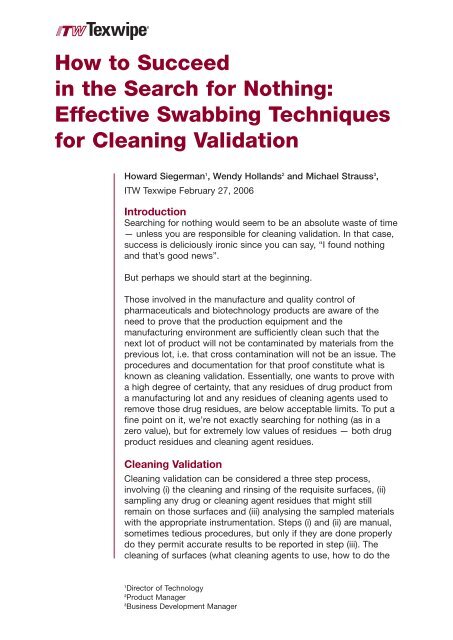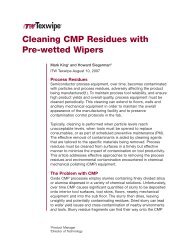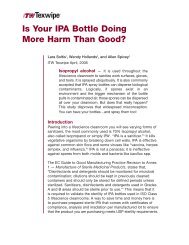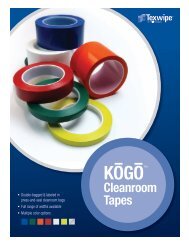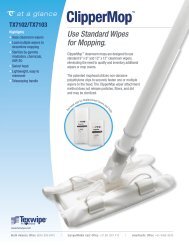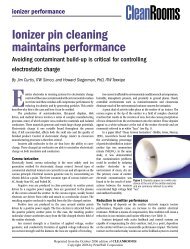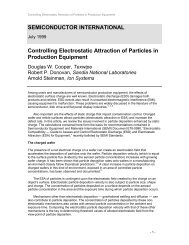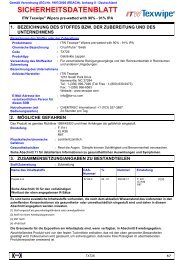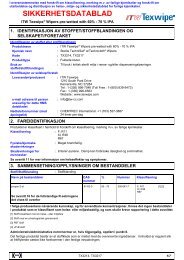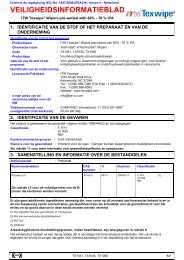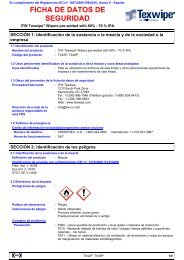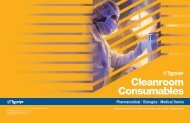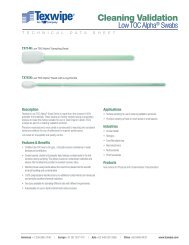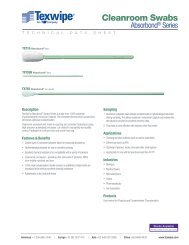How to Suceed in the Search for Nothing - Texwipe
How to Suceed in the Search for Nothing - Texwipe
How to Suceed in the Search for Nothing - Texwipe
Create successful ePaper yourself
Turn your PDF publications into a flip-book with our unique Google optimized e-Paper software.
<strong>How</strong> <strong>to</strong> Succeed<br />
<strong>in</strong> <strong>the</strong> <strong>Search</strong> <strong>for</strong> Noth<strong>in</strong>g:<br />
Effective Swabb<strong>in</strong>g Techniques<br />
<strong>for</strong> Clean<strong>in</strong>g Validation<br />
<strong>How</strong>ard Siegerman 1 , Wendy Hollands 2 and Michael Strauss 3 ,<br />
ITW <strong>Texwipe</strong> February 27, 2006<br />
Introduction<br />
<strong>Search</strong><strong>in</strong>g <strong>for</strong> noth<strong>in</strong>g would seem <strong>to</strong> be an absolute waste of time<br />
— unless you are responsible <strong>for</strong> clean<strong>in</strong>g validation. In that case,<br />
success is deliciously ironic s<strong>in</strong>ce you can say, “I found noth<strong>in</strong>g<br />
and that’s good news”.<br />
But perhaps we should start at <strong>the</strong> beg<strong>in</strong>n<strong>in</strong>g.<br />
Those <strong>in</strong>volved <strong>in</strong> <strong>the</strong> manufacture and quality control of<br />
pharmaceuticals and biotechnology products are aware of <strong>the</strong><br />
need <strong>to</strong> prove that <strong>the</strong> production equipment and <strong>the</strong><br />
manufactur<strong>in</strong>g environment are sufficiently clean such that <strong>the</strong><br />
next lot of product will not be contam<strong>in</strong>ated by materials from <strong>the</strong><br />
previous lot, i.e. that cross contam<strong>in</strong>ation will not be an issue. The<br />
procedures and documentation <strong>for</strong> that proof constitute what is<br />
known as clean<strong>in</strong>g validation. Essentially, one wants <strong>to</strong> prove with<br />
a high degree of certa<strong>in</strong>ty, that any residues of drug product from<br />
a manufactur<strong>in</strong>g lot and any residues of clean<strong>in</strong>g agents used <strong>to</strong><br />
remove those drug residues, are below acceptable limits. To put a<br />
f<strong>in</strong>e po<strong>in</strong>t on it, we’re not exactly search<strong>in</strong>g <strong>for</strong> noth<strong>in</strong>g (as <strong>in</strong> a<br />
zero value), but <strong>for</strong> extremely low values of residues — both drug<br />
product residues and clean<strong>in</strong>g agent residues.<br />
Clean<strong>in</strong>g Validation<br />
Clean<strong>in</strong>g validation can be considered a three step process,<br />
<strong>in</strong>volv<strong>in</strong>g (i) <strong>the</strong> clean<strong>in</strong>g and r<strong>in</strong>s<strong>in</strong>g of <strong>the</strong> requisite surfaces, (ii)<br />
sampl<strong>in</strong>g any drug or clean<strong>in</strong>g agent residues that might still<br />
rema<strong>in</strong> on those surfaces and (iii) analys<strong>in</strong>g <strong>the</strong> sampled materials<br />
with <strong>the</strong> appropriate <strong>in</strong>strumentation. Steps (i) and (ii) are manual,<br />
sometimes tedious procedures, but only if <strong>the</strong>y are done properly<br />
do <strong>the</strong>y permit accurate results <strong>to</strong> be reported <strong>in</strong> step (iii). The<br />
clean<strong>in</strong>g of surfaces (what clean<strong>in</strong>g agents <strong>to</strong> use, how <strong>to</strong> do <strong>the</strong><br />
1<br />
Direc<strong>to</strong>r of Technology<br />
2<br />
Product Manager<br />
3<br />
Bus<strong>in</strong>ess Development Manager
clean<strong>in</strong>g, etc.) and <strong>the</strong> analysis of <strong>the</strong> sampled materials<br />
(calibration curves, limits of detection) are <strong>the</strong>mselves fasc<strong>in</strong>at<strong>in</strong>g<br />
<strong>to</strong>pics (at least <strong>to</strong> some people), but <strong>the</strong>y are not our focus here.<br />
For this discussion, we will look only at step (ii) — <strong>the</strong> procedures<br />
that enable one <strong>to</strong> sample a cleaned surface with a high degree of<br />
reproducibility, <strong>to</strong> ensure that what is reported <strong>in</strong> step (iii) truly<br />
represents <strong>the</strong> condition of <strong>the</strong> sampled surface.<br />
It may seem <strong>in</strong>tuitively obvious, but one does not beg<strong>in</strong> <strong>the</strong> clean<strong>in</strong>g<br />
validation process until <strong>the</strong>re is an absence of visible residue on<br />
<strong>the</strong> surface. Residues are visible at surface concentrations of<br />
between 1 and 4 ug/cm 2 . The simple rule is that if you can still see<br />
residues on <strong>the</strong> surface, <strong>for</strong>get about any sampl<strong>in</strong>g activities, you<br />
haven’t f<strong>in</strong>ished step (i) — <strong>the</strong> clean<strong>in</strong>g activities.<br />
Sampl<strong>in</strong>g Surfaces with Swabs<br />
Assum<strong>in</strong>g <strong>the</strong> surface is free of visible residue<br />
(i.e. that <strong>the</strong> clean<strong>in</strong>g stage is done), <strong>the</strong> challenge<br />
is now <strong>to</strong> sample that surface <strong>in</strong> a reproducible<br />
manner, such that any (<strong>in</strong>visible) residues, present<br />
<strong>in</strong> extremely small amounts, are collected and<br />
delivered <strong>to</strong> <strong>the</strong> <strong>in</strong>strument <strong>for</strong> measurement. The<br />
best type of swab <strong>for</strong> sampl<strong>in</strong>g is one with a<br />
head made of laundered polyester knit fabric<br />
(Figure 1), s<strong>in</strong>ce that material provides <strong>the</strong> lowest<br />
levels of releasable particles, <strong>the</strong> highest recovery<br />
and <strong>the</strong> lowest background when <strong>to</strong>tal organic<br />
Figure 1 – A polyester knit swab carbon (TOC) measurements are employed as <strong>the</strong><br />
used <strong>for</strong> surface sampl<strong>in</strong>g<br />
analytical technique. To sample <strong>the</strong> surface, <strong>the</strong><br />
swab is moistened <strong>the</strong>n drawn across <strong>the</strong> surface<br />
<strong>in</strong> a thorough and reproducible manner <strong>to</strong> collect any residue <strong>in</strong><strong>to</strong><br />
<strong>the</strong> <strong>in</strong>terstices of <strong>the</strong> polyester knit fabric. The swab is <strong>the</strong>n<br />
deposited <strong>in</strong><strong>to</strong> a suitable collection vial, <strong>the</strong>n <strong>the</strong> residues<br />
extracted from <strong>the</strong> swab head <strong>for</strong> subsequent analysis.<br />
It is worth devot<strong>in</strong>g a moment <strong>to</strong> <strong>the</strong> technique <strong>for</strong> moisten<strong>in</strong>g a<br />
swab, s<strong>in</strong>ce errors <strong>in</strong> technique here will lead <strong>to</strong> <strong>in</strong>consistent<br />
results. There might be a temptation <strong>to</strong> simply saturate <strong>the</strong> swab<br />
head with high-quality (e.g. TOC-grade) water <strong>to</strong> do <strong>the</strong> residue<br />
collection. This will cause problems, s<strong>in</strong>ce <strong>the</strong> excess liquid on <strong>the</strong><br />
swab head will simply spread <strong>the</strong> residue over <strong>the</strong> surface <strong>to</strong> be<br />
sampled and will not allow <strong>the</strong> residue <strong>to</strong> be picked up reproducibly<br />
<strong>in</strong><strong>to</strong> <strong>the</strong> swab fabric. For best results, <strong>the</strong> swab should be damp,<br />
but not saturated. This is best accomplished by immers<strong>in</strong>g <strong>the</strong><br />
head <strong>in</strong><strong>to</strong> a conta<strong>in</strong>er of high-quality water, and press<strong>in</strong>g both<br />
sides of <strong>the</strong> swab head aga<strong>in</strong>st <strong>the</strong> side of <strong>the</strong> conta<strong>in</strong>er a few<br />
times <strong>to</strong> expel any air trapped <strong>in</strong> <strong>the</strong> fabric and allow <strong>the</strong> water <strong>to</strong><br />
fully penetrate <strong>the</strong> fabric. Then <strong>the</strong> swab head is raised out of <strong>the</strong>
water and <strong>the</strong> flat sides of <strong>the</strong> swab are drawn across <strong>the</strong> rim of<br />
<strong>the</strong> conta<strong>in</strong>er <strong>to</strong> expel excess water and leave <strong>the</strong> swab head<br />
moist. The degree of moistness of <strong>the</strong> swab head (o<strong>the</strong>rwise<br />
known as <strong>the</strong> percent wett<strong>in</strong>g level) need not be identical from run<br />
<strong>to</strong> run, s<strong>in</strong>ce residues will be picked up over a fairly wide range of<br />
swab head moistness.<br />
Ideally, <strong>to</strong> maximize reproducibility <strong>in</strong> swab head<br />
moistness, one would like <strong>to</strong> be able <strong>to</strong> dispense<br />
<strong>the</strong> optimum amount of water on<strong>to</strong> <strong>the</strong> swab<br />
head from a micropipet <strong>to</strong> produce, say, a 50%<br />
wett<strong>in</strong>g level, but un<strong>for</strong>tunately this is impractical.<br />
The swab head material is not <strong>to</strong>tally hydrophilic<br />
and water dispensed <strong>in</strong> such a manner will simply<br />
bead up on <strong>the</strong> swab head and will not be<br />
absorbed by <strong>the</strong> fabric.<br />
Figure 2 – A template <strong>for</strong> surface<br />
sampl<strong>in</strong>g<br />
Figure 3 – Swabb<strong>in</strong>g patterns<br />
Figure 4 – A notched swab handle<br />
simplifies separat<strong>in</strong>g <strong>the</strong> swab head<br />
from <strong>the</strong> handle. Only <strong>the</strong> head<br />
needs <strong>to</strong> be extracted <strong>for</strong> TOC<br />
measurement.<br />
The manner <strong>in</strong> which <strong>the</strong> swab is used <strong>to</strong> sample<br />
<strong>the</strong> surface, i.e. <strong>the</strong> swabb<strong>in</strong>g pattern, is critical<br />
<strong>to</strong> ensure accurate and reproducible collection of<br />
residues. For easily accessible surfaces, a<br />
template with a 5 cm x 5 cm open<strong>in</strong>g can be<br />
used <strong>to</strong> sample <strong>the</strong> same surface area each time<br />
(Figure 2). As with wip<strong>in</strong>g, l<strong>in</strong>ear overlapp<strong>in</strong>g<br />
strokes over <strong>the</strong> surface <strong>to</strong> be sampled will<br />
ensure that <strong>the</strong> residue is collected <strong>in</strong><strong>to</strong> <strong>the</strong> moist<br />
swab head. Figure 3 shows a typical sampl<strong>in</strong>g<br />
pattern employ<strong>in</strong>g 2 swabs. The first side of <strong>the</strong><br />
first swab is swiped horizontally 10 times over<br />
<strong>the</strong> template open<strong>in</strong>g, <strong>the</strong>n <strong>the</strong> swab is flipped<br />
over and <strong>the</strong> second side is swiped vertically 10<br />
times over <strong>the</strong> same surface. This swab is<br />
deposited <strong>in</strong><strong>to</strong> <strong>the</strong> collection vial (Figure 4). The<br />
first side of <strong>the</strong> second swab is swiped diagonally<br />
upwards 10 times, <strong>the</strong>n flipped over and <strong>the</strong><br />
second side swiped diagonally downward 10<br />
times. The second swab is deposited <strong>in</strong><strong>to</strong> <strong>the</strong><br />
same collection vial. In this manner, <strong>the</strong> surface<br />
has been swabbed a <strong>to</strong>tal of 40 times, and <strong>the</strong>re<br />
is a reasonable expectation that any residue on<br />
<strong>the</strong> surface has been transferred <strong>in</strong><strong>to</strong> <strong>the</strong> two<br />
swab heads. It is not required <strong>to</strong> use two swabs;<br />
often one will do.<br />
Opera<strong>to</strong>rs can verify that <strong>the</strong>ir technique <strong>for</strong><br />
dampen<strong>in</strong>g <strong>the</strong> swab heads and swabb<strong>in</strong>g<br />
surfaces is appropriate through replicate recovery<br />
experiments of known challenges dispensed on<strong>to</strong>
sample surfaces. Ideally, one would like <strong>to</strong> recover 100% of <strong>the</strong><br />
challenge, but recoveries may be limited <strong>to</strong> 75%-80%, depend<strong>in</strong>g<br />
on <strong>the</strong> sampl<strong>in</strong>g conditions and <strong>the</strong> residue. It must be recognized<br />
that <strong>the</strong> swab head may not get everyth<strong>in</strong>g off <strong>the</strong> surface and<br />
that <strong>the</strong> extraction liquid may not get all of <strong>the</strong> residue out of <strong>the</strong><br />
swab head. Indeed, a 90% efficiency at each stage, produces an<br />
overall recovery of only 81% (i.e. 0.9 x 0.9).<br />
Pre-cleaned vials and swabs are available commercially that provide<br />
TOC background levels of


